Abstract
To assess the mechanisms responsible for increased gluconeogenesis in noninsulin-dependent diabetes mellitus (NIDDM), we infused [3-14C]lactate, [3-13C]alanine, and [6-3H]glucose in 10 postabsorptive NIDDM subjects and in 9 age- and weight-matched nondiabetic volunteers and measured systemic appearance of alanine and lactate, their release from forearm tissues, and their conversion into plasma glucose (corrected for Krebs cycle carbon exchange). Systemic appearance of lactate and alanine were both significantly greater in diabetic subjects (18.2 +/- 0.9 and 5.8 +/- 0.4 mumol/kg/min, respectively) than in the nondiabetic volunteers (12.6 +/- 0.7 and 4.2 +/- 0.3 mumol/kg/min, respectively, P less than 0.001 and P less than 0.01). Conversions of lactate and alanine to glucose were also both significantly greater in NIDDM subjects (8.6 +/- 0.5 and 2.4 +/- 0.1 mumole/kg/min, respectively) than in nondiabetic volunteers (4.2 +/- 0.4 and 1.8 +/- 0.1 mumol/kg/min, respectively, P less than 0.001 and P less than 0.025). The proportion of systemic alanine appearance converted to glucose was not increased in NIDDM subjects (42.7 +/- 1.9 vs. 44.2 +/- 2.9% in nondiabetic volunteers), whereas the proportion of systemic lactate appearance converted to glucose was increased in NIDDM subjects (48.3 +/- 3.8 vs. 34.2 +/- 3.8% in nondiabetic volunteers, P less than 0.025); the latter increased hepatic efficiency accounted for approximately 40% of the increased lactate conversion to glucose. Neither forearm nor total body muscle lactate and alanine release was significantly different in NIDDM and nondiabetic volunteers. Therefore, we conclude that increased substrate delivery to the liver and increased efficiency of intrahepatic substrate conversion to glucose are both important factors for the increased gluconeogenesis of NIDDM and that tissues other than muscle are responsible for the increased delivery of gluconeogenic precursors to the liver.
Full text
PDF

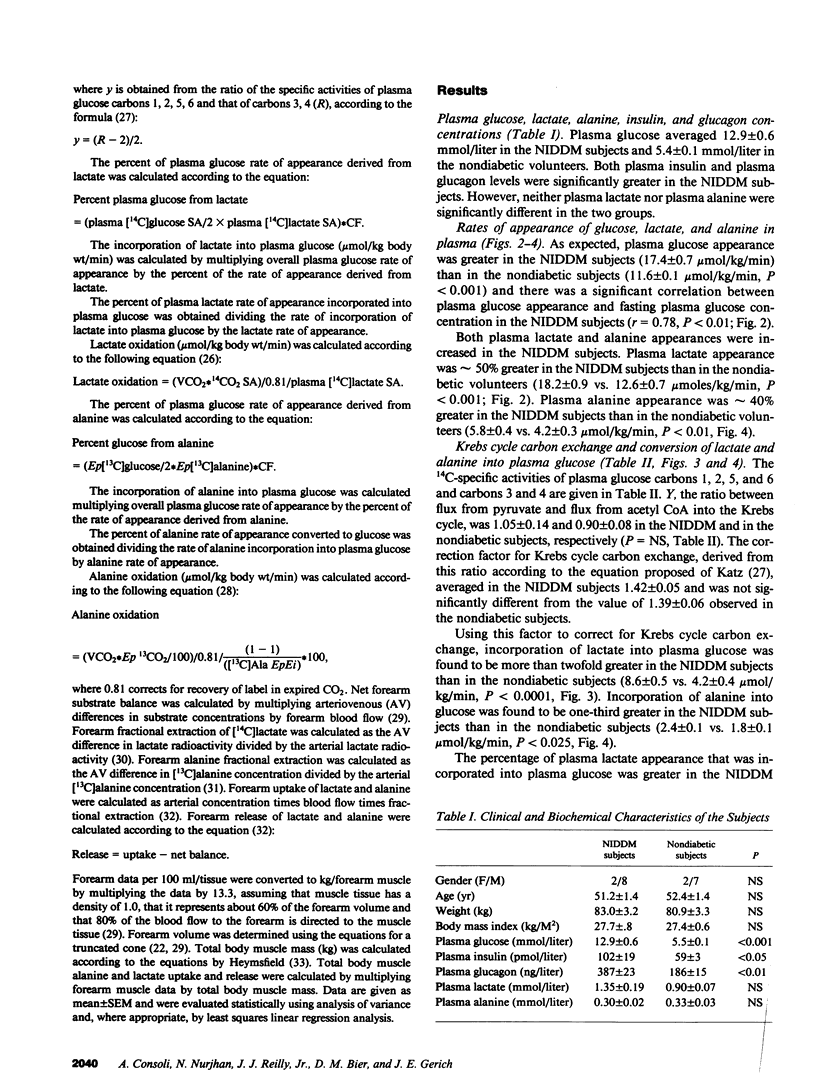
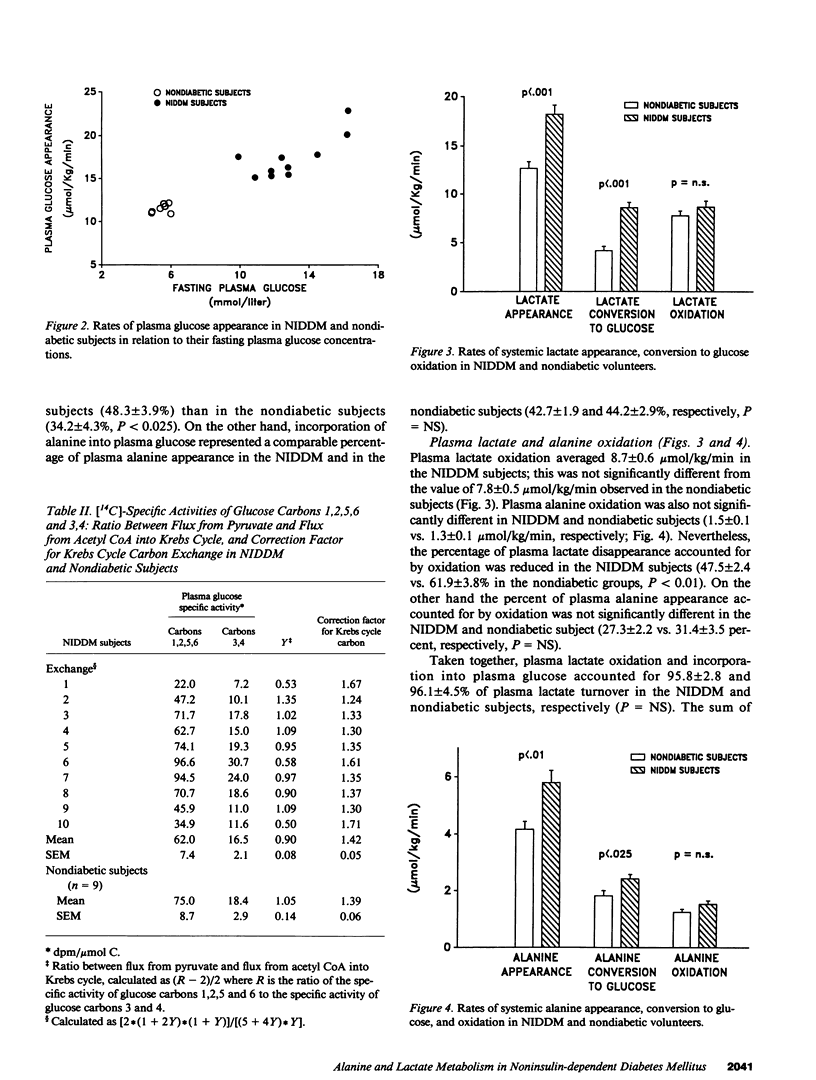
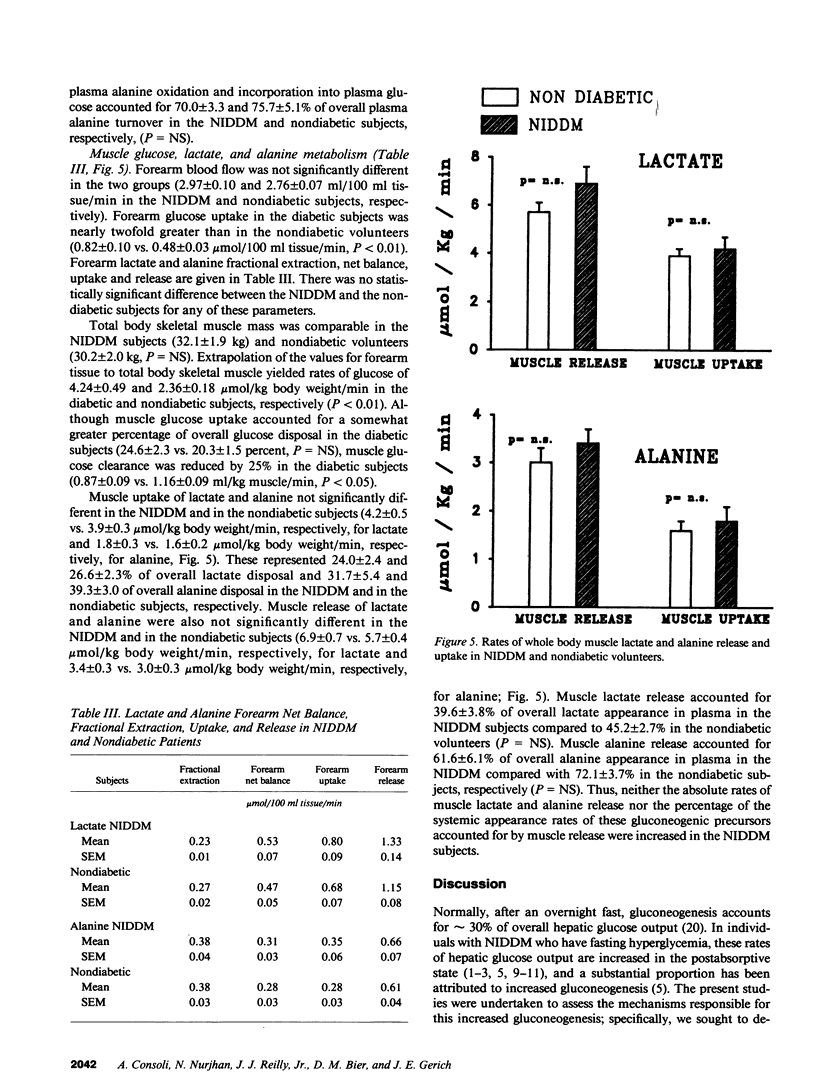
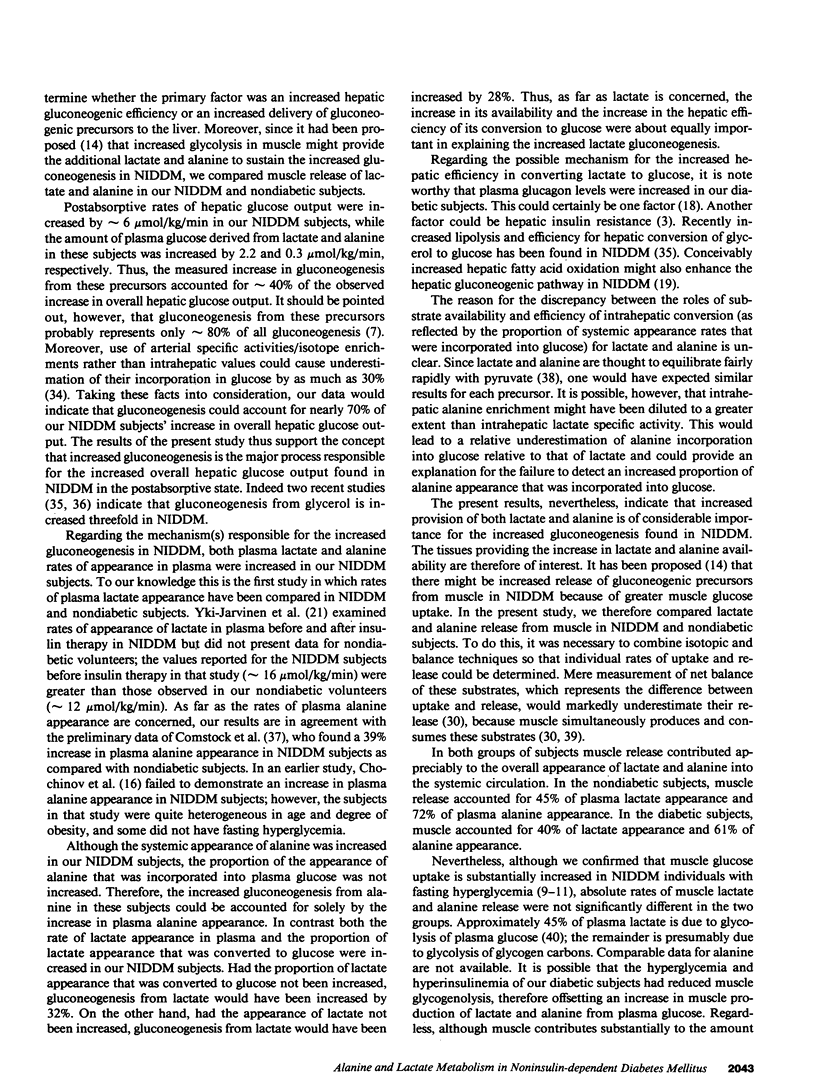

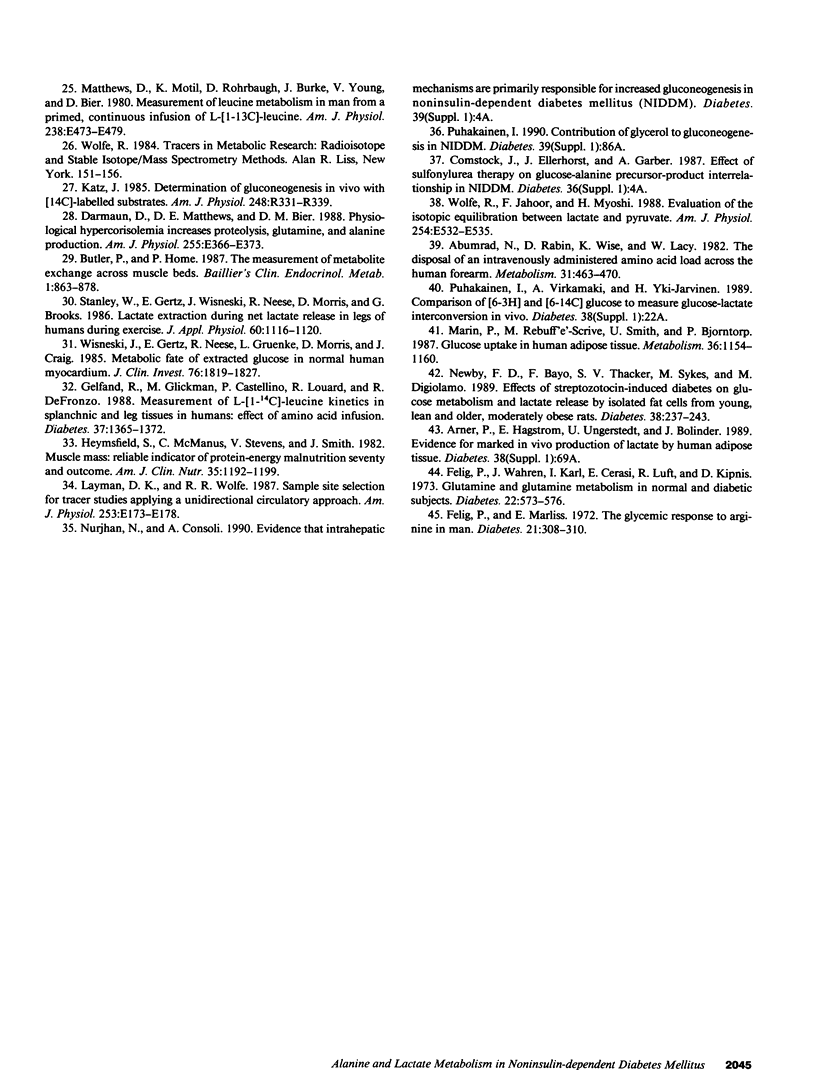
Selected References
These references are in PubMed. This may not be the complete list of references from this article.
- Abumrad N. N., Rabin D., Wise K. L., Lacy W. W. The disposal of an intravenously administered amino acid load across the human forearm. Metabolism. 1982 May;31(5):463–470. doi: 10.1016/0026-0495(82)90235-9. [DOI] [PubMed] [Google Scholar]
- Best J. D., Judzewitsch R. G., Pfeifer M. A., Beard J. C., Halter J. B., Porte D., Jr The effect of chronic sulfonylurea therapy on hepatic glucose production in non-insulin-dependent diabetes. Diabetes. 1982 Apr;31(4 Pt 1):333–338. doi: 10.2337/diab.31.4.333. [DOI] [PubMed] [Google Scholar]
- Bier D. M., Arnold K. J., Sherman W. R., Holland W. H., Holmes W. F., Kipnis D. M. In-vivo measurement of glucose and alanine metabolism with stable isotopic tracers. Diabetes. 1977 Nov;26(11):1005–1015. doi: 10.2337/diab.26.11.1005. [DOI] [PubMed] [Google Scholar]
- Bogardus C., Taskinen M. R., Zawadzki J., Lillioja S., Mott D., Howard B. V. Increased resting metabolic rates in obese subjects with non-insulin-dependent diabetes mellitus and the effect of sulfonylurea therapy. Diabetes. 1986 Jan;35(1):1–5. doi: 10.2337/diab.35.1.1. [DOI] [PubMed] [Google Scholar]
- Butler P. C., Home P. D. The measurement of metabolite exchange across muscle beds. Baillieres Clin Endocrinol Metab. 1987 Nov;1(4):863–878. doi: 10.1016/s0950-351x(87)80009-5. [DOI] [PubMed] [Google Scholar]
- Cahill G. F., Jr Starvation in man. N Engl J Med. 1970 Mar 19;282(12):668–675. doi: 10.1056/NEJM197003192821209. [DOI] [PubMed] [Google Scholar]
- Campbell P. J., Mandarino L. J., Gerich J. E. Quantification of the relative impairment in actions of insulin on hepatic glucose production and peripheral glucose uptake in non-insulin-dependent diabetes mellitus. Metabolism. 1988 Jan;37(1):15–21. doi: 10.1016/0026-0495(88)90023-6. [DOI] [PubMed] [Google Scholar]
- Chochinov R. H., Bowen H. F., Moorhouse J. A. Circulating alanine disposal in diabetes mellitus. Diabetes. 1978 Apr;27(4):420–426. doi: 10.2337/diab.27.4.420. [DOI] [PubMed] [Google Scholar]
- Consoli A., Kennedy F., Miles J., Gerich J. Determination of Krebs cycle metabolic carbon exchange in vivo and its use to estimate the individual contributions of gluconeogenesis and glycogenolysis to overall glucose output in man. J Clin Invest. 1987 Nov;80(5):1303–1310. doi: 10.1172/JCI113206. [DOI] [PMC free article] [PubMed] [Google Scholar]
- Consoli A., Nurjhan N., Capani F., Gerich J. Predominant role of gluconeogenesis in increased hepatic glucose production in NIDDM. Diabetes. 1989 May;38(5):550–557. doi: 10.2337/diab.38.5.550. [DOI] [PubMed] [Google Scholar]
- DE MEUTTER R. C., SHREEVE W. W. Conversion of DL-lactate-2-C14 or -3-C14 or pyruvate-2-C14 to blood glucose in humans: effects of diabetes, insulin, tolbutamide, and glucose load. J Clin Invest. 1963 Apr;42:525–533. doi: 10.1172/JCI104741. [DOI] [PMC free article] [PubMed] [Google Scholar]
- Darmaun D., Matthews D. E., Bier D. M. Physiological hypercortisolemia increases proteolysis, glutamine, and alanine production. Am J Physiol. 1988 Sep;255(3 Pt 1):E366–E373. doi: 10.1152/ajpendo.1988.255.3.E366. [DOI] [PubMed] [Google Scholar]
- DeFronzo R. A., Gunnarsson R., Björkman O., Olsson M., Wahren J. Effects of insulin on peripheral and splanchnic glucose metabolism in noninsulin-dependent (type II) diabetes mellitus. J Clin Invest. 1985 Jul;76(1):149–155. doi: 10.1172/JCI111938. [DOI] [PMC free article] [PubMed] [Google Scholar]
- DeFronzo R. A., Simonson D., Ferrannini E. Hepatic and peripheral insulin resistance: a common feature of type 2 (non-insulin-dependent) and type 1 (insulin-dependent) diabetes mellitus. Diabetologia. 1982 Oct;23(4):313–319. doi: 10.1007/BF00253736. [DOI] [PubMed] [Google Scholar]
- Felber J. P., Ferrannini E., Golay A., Meyer H. U., Theibaud D., Curchod B., Maeder E., Jequier E., DeFronzo R. A. Role of lipid oxidation in pathogenesis of insulin resistance of obesity and type II diabetes. Diabetes. 1987 Nov;36(11):1341–1350. doi: 10.2337/diab.36.11.1341. [DOI] [PubMed] [Google Scholar]
- Felig P., Wahren J., Karl I., Cerasi E., Luft R., Kipnis D. M. Glutamine and glutamate metabolism in normal and diabetic subjects. Diabetes. 1973 Aug;22(8):573–576. doi: 10.2337/diab.22.8.573. [DOI] [PubMed] [Google Scholar]
- Firth R. G., Bell P. M., Marsh H. M., Hansen I., Rizza R. A. Postprandial hyperglycemia in patients with noninsulin-dependent diabetes mellitus. Role of hepatic and extrahepatic tissues. J Clin Invest. 1986 May;77(5):1525–1532. doi: 10.1172/JCI112467. [DOI] [PMC free article] [PubMed] [Google Scholar]
- Gelfand R. A., Glickman M. G., Castellino P., Louard R. J., DeFronzo R. A. Measurement of L-[1-14C]leucine kinetics in splanchnic and leg tissues in humans. Effect of amino acid infusion. Diabetes. 1988 Oct;37(10):1365–1372. doi: 10.2337/diab.37.10.1365. [DOI] [PubMed] [Google Scholar]
- Gerich J. E., Mitrakou A., Kelley D., Mandarino L., Nurjhan N., Reilly J., Jenssen T., Veneman T., Consoli A. Contribution of impaired muscle glucose clearance to reduced postabsorptive systemic glucose clearance in NIDDM. Diabetes. 1990 Feb;39(2):211–216. doi: 10.2337/diab.39.2.211. [DOI] [PubMed] [Google Scholar]
- Heymsfield S. B., McManus C., Stevens V., Smith J. Muscle mass: reliable indicator of protein-energy malnutrition severity and outcome. Am J Clin Nutr. 1982 May;35(5 Suppl):1192–1199. doi: 10.1093/ajcn/35.5.1192. [DOI] [PubMed] [Google Scholar]
- Kelley D., Mitrakou A., Marsh H., Schwenk F., Benn J., Sonnenberg G., Arcangeli M., Aoki T., Sorensen J., Berger M. Skeletal muscle glycolysis, oxidation, and storage of an oral glucose load. J Clin Invest. 1988 May;81(5):1563–1571. doi: 10.1172/JCI113489. [DOI] [PMC free article] [PubMed] [Google Scholar]
- Kreisberg R. A. Glucose-lactate inter-relations in man. N Engl J Med. 1972 Jul 20;287(3):132–137. doi: 10.1056/NEJM197207202870307. [DOI] [PubMed] [Google Scholar]
- Layman D. K., Wolfe R. R. Sample site selection for tracer studies applying a unidirectional circulatory approach. Am J Physiol. 1987 Aug;253(2 Pt 1):E173–E178. doi: 10.1152/ajpendo.1987.253.2.E173. [DOI] [PubMed] [Google Scholar]
- Matthews D. E., Ben-Galim E., Bier D. M. Determination of stable isotopic enrichment in individual plasma amino acids by chemical ionization mass spectrometry. Anal Chem. 1979 Jan;51(1):80–84. doi: 10.1021/ac50037a028. [DOI] [PubMed] [Google Scholar]
- Matthews D. E., Motil K. J., Rohrbaugh D. K., Burke J. F., Young V. R., Bier D. M. Measurement of leucine metabolism in man from a primed, continuous infusion of L-[1-3C]leucine. Am J Physiol. 1980 May;238(5):E473–E479. doi: 10.1152/ajpendo.1980.238.5.E473. [DOI] [PubMed] [Google Scholar]
- Mårin P., Rebuffé-Scrive M., Smith U., Björntorp P. Glucose uptake in human adipose tissue. Metabolism. 1987 Dec;36(12):1154–1160. doi: 10.1016/0026-0495(87)90242-3. [DOI] [PubMed] [Google Scholar]
- Newby F. D., Bayo F., Thacker S. V., Sykes M., DiGirolamo M. Effects of streptozocin-induced diabetes on glucose metabolism and lactate release by isolated fat cells from young lean and older, moderately obese rats. Diabetes. 1989 Feb;38(2):237–243. doi: 10.2337/diab.38.2.237. [DOI] [PubMed] [Google Scholar]
- Stanley W. C., Gertz E. W., Wisneski J. A., Neese R. A., Morris D. L., Brooks G. A. Lactate extraction during net lactate release in legs of humans during exercise. J Appl Physiol (1985) 1986 Apr;60(4):1116–1120. doi: 10.1152/jappl.1986.60.4.1116. [DOI] [PubMed] [Google Scholar]
- Unger R. H., Aguilar-Parada E., Müller W. A., Eisentraut A. M. Studies of pancreatic alpha cell function in normal and diabetic subjects. J Clin Invest. 1970 Apr;49(4):837–848. doi: 10.1172/JCI106297. [DOI] [PMC free article] [PubMed] [Google Scholar]
- Williamson J. R., Kreisberg R. A., Felts P. W. Mechanism for the stimulation of gluconeogenesis by fatty acids in perfused rat liver. Proc Natl Acad Sci U S A. 1966 Jul;56(1):247–254. doi: 10.1073/pnas.56.1.247. [DOI] [PMC free article] [PubMed] [Google Scholar]
- Wisneski J. A., Gertz E. W., Neese R. A., Gruenke L. D., Morris D. L., Craig J. C. Metabolic fate of extracted glucose in normal human myocardium. J Clin Invest. 1985 Nov;76(5):1819–1827. doi: 10.1172/JCI112174. [DOI] [PMC free article] [PubMed] [Google Scholar]
- Wolfe R. R., Jahoor F., Miyoshi H. Evaluation of the isotopic equilibration between lactate and pyruvate. Am J Physiol. 1988 Apr;254(4 Pt 1):E532–E535. doi: 10.1152/ajpendo.1988.254.4.E532. [DOI] [PubMed] [Google Scholar]
- Yki-Järvinen H., Helve E., Sane T., Nurjhan N., Taskinen M. R. Insulin inhibition of overnight glucose production and gluconeogenesis from lactate in NIDDM. Am J Physiol. 1989 Jun;256(6 Pt 1):E732–E739. doi: 10.1152/ajpendo.1989.256.6.E732. [DOI] [PubMed] [Google Scholar]
- Zawadzki J. K., Wolfe R. R., Mott D. M., Lillioja S., Howard B. V., Bogardus C. Increased rate of Cori cycle in obese subjects with NIDDM and effect of weight reduction. Diabetes. 1988 Feb;37(2):154–159. doi: 10.2337/diab.37.2.154. [DOI] [PubMed] [Google Scholar]


